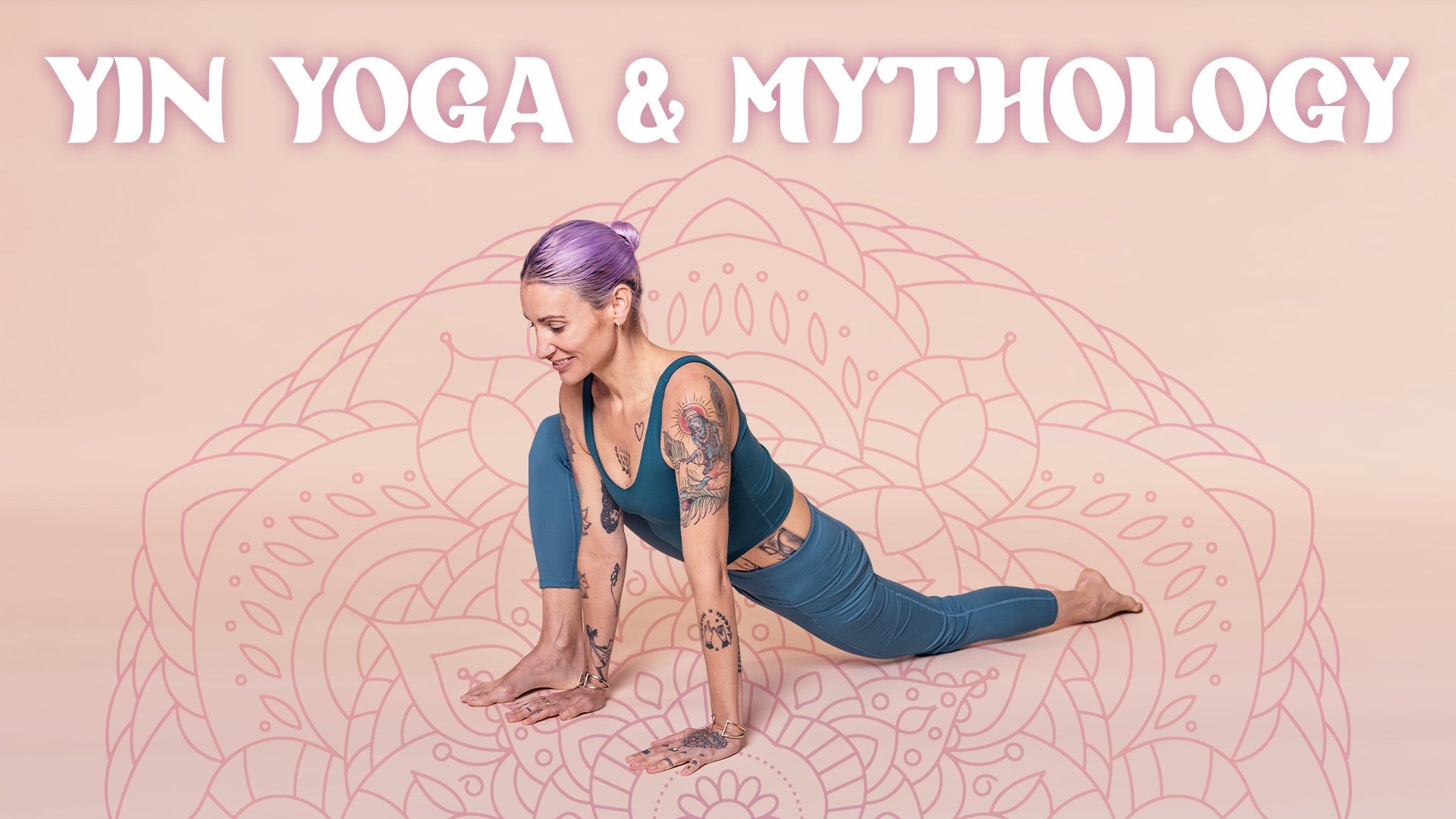Description
About This Video
Transcript
Read Full Transcript
Welcome. I'm Kelly Kam and I'm here to teach mythology-based yin yoga. In this practice we'll be inspired by the goddess Saraswati. Saraswati is the goddess of poetry, music, art, and wisdom. Her name literally means the one who flows. And so we begin today by flowing down onto our mats, onto our backs in banana asana. For each pose today I'll offer some options. To begin with you can come down onto your back and stretch your legs out long. Your arms can reach over your head. At any point if the arms feel like too much you can bring the arms down. The arms are just extra. But to start with we'll take one leg, the right leg, and just slide it over a few inches to the side. And then the left ankle can come and cross on top of it. From there the upper body bends in the same way just a little gentle curve over towards the right side. You're welcome to hold onto your wrists or just let the arms hang. So another option here is that you could use a bolster or a pillow. A pillow works just fine. And just lean it against the outside hip which provides such a lovely extra bit of grounding here. And so once you find the shape just allow yourself to really settle. Imagine yourself like water, like a river. As you breathe in you feel the top of you, the front of your body, sparkle like a river in the sunshine. And as you breathe out you can imagine all the waters of you seeking the low place, sinking towards the back of your body. Scanning your whole body from bottom to top. Looking for anywhere that you're gripping or holding. And just inviting every part of you to uncoil, to spread out, and to soften. We'll hold these shapes today for a few minutes at a time. But if you need to come out sooner of course you're always welcome to. And you'll hear bits and pieces of the story of Saraswati as we go through each shape. In Hindu mythology and in many mythologies the world is destroyed and recreated many, many times. I know I can certainly relate to that as I feel like my life has come apart at the seams and been put back together a few times. In one of these moments when the world was being recreated the God Brahma, the creator God, was in charge. And in a frenzy of creation he whipped up mountains and people and animals and oceans and trees. But everything was a great big mess. He was working so fast without any thought. The mountains were upside down. The dogs were speaking and the humans were barking. The rivers were flowing backwards. The trees were upside down. When Brahma finally paused and looked around he realized what a mess he had made. And when he realized it he knelt by the river in front of him and he cried. Through his tears he noticed the beautiful river in front of him flowing so perfectly so effortlessly. And he thought that's what I want. That's what I want for this world. Flow, ease, beauty and effortlessness. Take a few more breaths here letting the whole body just flow like you're made of soft water. Your skin quiet, your face quiet and every muscle loosening from the bone. So we'll begin to transition out of banana asana before we hear the rest of the story.
So you can start to undo the shape. If you had a prop gently pushing the prop out of the way then as you return from your banana it might be lovely to just curl up on the opposite side. So curling up on your left side. Then a little fetal position just resting. So between each shape we'll pause, we'll rest, we'll give the body time to acclimate to let the last shape wash off before we start fresh again on the other side. So taking a couple of settling breaths. And these in between moments too all offer suggestions but if there are other things that your body craves you can always listen to your body. You're your best teacher. So if you feel sufficiently ready like you come back to neutral and can begin again and we'll take banana on the other side. So returning to your back, stretching the legs long, reaching the arms overhead if you're doing arms overhead otherwise arms down by your side. This time the left leg will slide over to the left. It's not much maybe four inches, six inches. The right leg follows, it can cross on top. And then if you're using the arms same thing with the upper body curving in the direction of the legs. So you create almost like a sliver of a crescent moon, a really gentle shape. You have the option of using the bolster or not. And then once you arrive just really letting everything settle towards the bottom of you. Thinking about yourself as if you were water. Where the water of you would pool. Perhaps in your palms, perhaps in the back of your skull. In the inner lining of your back waist. In the heels, let your water settle. And then we'll continue with our story. So where we left off, Brahma had created quite a huge mess of things. And he was kneeling by a river and wondering what to do. And through his tears, he watched this beautiful river flowing and he thought that that's what I want. So he knelt by the river and he asked the river to please incarnate as a goddess, to be his helper, to make the world more beautiful and organized. And so the river began to swirl. Her water started to churn. And before he knew it in front of him, Brahma saw this beautiful goddess, Saraswati, dressed in all white.
And she's the goddess of wisdom, of poetry, of music, of anything artistic. And he asked this goddess if she would help him. And pretty soon the world was much more beautiful. Through her power of art and creation, she organized the world. She made it beautiful once again. Imagine all your muscles just loosening right off the bones, everything flowing down in the direction of the earth, allowing your whole body to just descend. Just checking in as you continue to settle, perhaps you could soften around the jaw a little bit. Perhaps a layer of softening in the belly. Perhaps a bit more letting go through the lower body, the legs, the feet. So as we begin to transition out of this one now, same thing as before. You can undo it and then curl up on your right side. Soft. Fold it in like a little baby or a little bunny in a nest. And just letting that last shape wash away until you feel like the echo of it has really faded from your tissues, from your body. When you feel settled back to neutral, clear, you can begin to really quietly, gently crawl your way out onto your front side and we'll prepare for sphinx pose. I'm going to bring a bolster and a block because there's a couple of options for how to do this one. One thing I love is to put the bolster on top of the forearms. It gives a little extra weight, a little extra grounding. And then you've got a nice place for your head to rest. So that's one option. The other option that can be nice is to use a block on its medium or tall side. And often that's a good place to drop the forehead and settle in. And you can always do all of these shapes with no props, too. That's completely fine and wonderful. So I'm going to do it prop-less, but if you want to have your props, go for it. And then once you find your shape here, just settling in, elbows under the shoulders or thereabouts and the legs just streaming.
Now your legs like two mighty rivers just streaming behind you, soft and heavy. Letting everything just find its most natural place, letting your body land in a very organic way. So Saraswati helped Brahma make some order out of the messy world by using her power of art. It's sort of like when you have a really challenging time or you're feeling anxious and you journal. And sometimes doing something like that, just journaling, writing it out makes everything seem more clear, a little bit better. And so it's kind of like that kind of energy, a Saraswati energy. Or when you have to get away from it all and just put your headphones on and listen to some really good music. That's some Saraswati energy too. Often in this pose, I find that I have to check in again and again because if I'm not on top of it, everything starts to clench up again. So it's really helpful to just do a body scan, look in every little nook and cranny, every room in the house to turn the lights off. Sometimes we've got muscles that are just turned on all the time working for no reason. So as you look around your inner landscape, just noticing anywhere that you might be able to turn the lights off. Anywhere that you can loosen muscle from bone and just let yourself drop. Could check in with your face being soft around the mouth and easy around the eyes. Could check in with your hands, the quality of touch. Could there be a really sweet tenderness about your hands and how you touch the mat or the blanket that you're on? And checking in again with the seat and the legs, letting the legs just stream behind you, letting your water settle. So to transition out of the sphinx, you can just widen your elbows and a couple of options. You could pillow your hands to rest your forehead on them or do a one potato, two potato. You can also make cactus arms and turn your head to the side. And then the leg, one leg at a time. We'll do each leg for a few moments. You can come towards a little gentle half frog. I'm going to pillow my hands and rest my forehead. One thing to be mindful of is that in these in between moments as we transition that the transitions are also really slow and gentle. There's a very luxurious quiet quality about it. So at any point now you can switch the legs and then the other one, slide it up outside your hip and then let the head settle again. If you had the head turned, you might turn it to the opposite side. Not all heads like to do that. So if yours doesn't, that's fine too. You can keep it in the same direction that it was. And then we'll come out of this very carefully and slowly up onto all fours. And as you come to all fours, we'll head into swan pose. And there are a couple of options here. One is just to bring your left knee forward so that it's up towards the top of your mat, the right leg streaming behind you. If this causes any pain in your knee, ankle, hip, anywhere at all, you can flip it around and you can do a seated version, which is just as wonderful, just as effective. Otherwise, you're in a prone swan and you could always bring around any props in front of you to lean on or even underneath the hips if you want a little support there. I'm going to bring my elbows down and hang out right here without the props so that I can finish the story for you. So Saraswati, she's very wise. And one of the things about her that's really interesting is that she rides a swan. All the gods and goddesses have a vehicle, an animal friend that they hang around with. And Saraswati swan is especially interesting because the swan is known for its ability to float on the water. And no matter how dirty the water might be, the swan's feathers don't get muddy. And they say that the swan has an ability to separate milk from water, that if you pour milk into a pond, the swan can use its beak to drink just the milk out and not get any of the water. So it tells us something about discrimination and yoga, we call it Viveka. And Viveka is our ability to really discern what's good for us and what's not. Checking in again, looking for any coiling up that's happening, any blockages, anywhere it feels like there's a little traffic jam in your body. And just bring your attention there. And sometimes that's all it takes to loosen it. You don't have to force anything, but just place your loving attention on whatever spot feels sticky.
And often things will just loosen on their own. Last few exhales here. Let your breath really empty out all the way to the end. Maybe even noticing a little pause at the bottom of the exhale, a little quiet space. So sinking and settling, soft and heavy. Should imagine breathing right between your muscles and your skin into the whole outline of you, softening the whole surface of your body. Two more breaths. And then to transition out of this one, let's just come to lying on our backs. And we call it pentacle. You also know it as shavasana. So just a gentle flip around and a lie down. And you don't have to always be super still. We invite the suggestion of stillness in this practice, but it's never a mandate. So if you need to snuggle or wiggle around, that's always welcomed.
One of my teachers says that when we transition into yoga, it's nice to move like a mama cow, moving really gently across a meadow. And so as you come around and get ready for the next side of swan, think of yourself like a really gentle, wise and soft mama cow. And come around back onto your hands and knees unless you're doing the seated option, in which case you'll flip around and hook your right ankle over your left knee. Otherwise, you're coming onto all fours and bringing the right knee forward towards the right thumb, settling in, deciding if you want to use your props or not. And then finding a place where you can just let everything settle and spread out. Again, I'll bring my elbows down. You're welcome to bring your head down to stack a bunch of props in front of you to make it doable. And then when you arrive, just doing that check-in, going from the bones to the skin, the feet to the head, and just looking for anywhere that you might soften just a bit. It doesn't even have to be all the way. You could just think about it like, what if I soften 5% more? Maybe 10% more. So Sarah Swati's swan is perhaps a reminder to us that we can use our own power of discernment, Viveka, to stay a little bit above drama and things like that. You know how the swan is able to float on the surface without getting dirty. To me, that's a really nice reminder that we can do that too, that we can be in the world, but we don't have to step into a lot of messiness. We can use our power of discernment to do things like cultivate a really, really beautiful circle of friends and distance ourselves from things that are toxic and messy. We can use our wisdom to stay above drama. Maybe we resist making a mess. Maybe we resist getting in that Facebook argument. And we can instead make beautiful things. We can make art. Sarah Swati, to me, helps me remember that creating things keeps my life beautiful. When in doubt, listen to music, make music, write in your journal, paint something, sing something. Thinking about yourself like water again and letting all the water flow down. We're often so focused on up or up and out or moving forward, which is one of the great things about yin that instead we focus in and down. So calling all the threads of your attention back in and allowing every cell, every drop of you, every bit of blood, sweat, and tears to move down in the direction of the earth. So coming out of swan now, just very gently rolling onto your back. And we'll take a rest here, a Shavasana practice. And for Shavasana, you're welcome to lie on your back. You could always put a bolster underneath your knees, especially if you ever feel any twinges in your back. The Shavasana is more a state of mind than a position of the body. So you could also rest on your side, on your front, even sitting if you wanted to. But letting everything loosen, imagining all the cells in your body moving away from all the other ones equidistantly, like you're just spreading out in all directions, like a puddle on the floor, all the waters of you melting into the earth. All right.
You're very welcome to take a longer, Shavasana. If you have the time and space, otherwise you can join me in starting to wiggle the fingers, blink your eyes a few times, you could rock your head really gently from side to side, just start to feel your water swirling again. If it feels nice, you might take a big stretch or hug your knees in. And in that same slow way and that mama cow-like way, we'll come up to sit. There's no urgency at all.
When you do arrive sitting, if you come up, you can bring your right fingertips to touch the earth and your left hand over your heart. This is called Bumis Parsha Mudra, means calling witness or touching the earth. And so as we touch the earth and we touch our hearts, we let this be a reminder, may we remember beauty when life gets messy and challenging. May we remember how important art is and may we make this world a more beautiful place because we were here. And we can finish by bringing our palms together, bring them to a prayer in front of your chest.
Thank you so much for joining me. Until next time, bye-bye.
Yin Yoga and Mythology
Comments
You need to be a subscriber to post a comment.
Please Log In or Create an Account to start your free trial.
































